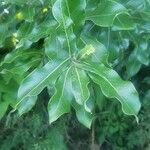A deciduous tree. It grows 25 m tall. The bark is grey-brown. It is smooth at first but becomes cracked with age. The leaves are oblong or sword shaped and 15 cm long by 7.5 cm wide. They end in a fine point. They do not have teeth along the edge. The leaves are yellow when young but become dark green. They have grey hairs underneath. The male and female flowers are borne separately on the same plant. The male flowers are more obvious and are in yellow-green drooping catkins. The fruit is an acorn which is 2 cm long. About one third is enclosed in a cup. The cup is covered with broad hairy scales.
Medium-sized tree; bark with flat gray ridges and shallow furrows; twigs soon glabrescent; lvs dark green, shining, firm, oblong or lance-oblong, occasionally oblong-obovate, 10–17 × 3.5–7 cm, bristle-tipped, entire, glabrous above, softly and loosely pubescent beneath; a crown of dry tan or brown leaves remaining well into winter and even into early spring; acorn 12–16 mm, the cup 6–8 mm, with relatively few and broad scales. Dry upland soils; e. Pa. to s. Mich., O., and Kans., s. to N.C., Ga., and Ark.




